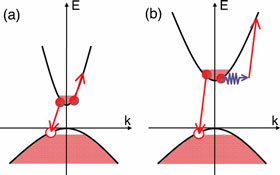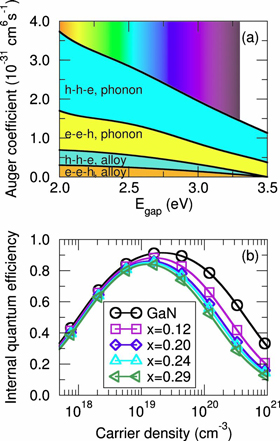- News
20 April 2011
UCSB theory blames indirect Auger recombination for nitride LED droop
University of California Santa Barbara (UCSB) theorists say that they have cracked the nitride semiconductor light-emitting diode (LED) lighting performance problem, commonly referred to as ‘efficiency droop’ [Emmanouil Kioupakis et al, Appl. Phys. Lett., vol98, p161107, 2011].
Nitride semiconductor LEDs use layers of indium gallium nitride (InGaN) alloy of InN and GaN compounds to form wells in which electrons and holes recombine to create light. It has been found that such devices have an increasing efficiency up to a certain current. Unfortunately, at higher currents beyond the peak the efficiency drops, often dramatically.
There has been much debate on the mechanism for this efficiency droop. Although the droop behavior has been attributed by some to Auger recombination, others comment that the size of this effect should be small.
Auger recombination usually involves two carriers recombining and transferring their energy to a third carrier rather than producing light. Since the process involves three carriers, it requires a high carrier density and hence would tend to kick in at higher current densities. However, calculations of simple ‘direct’ Auger recombination have suggested that the effect should be small.
The theorists at UCSB have been working on an indirect Auger process for some time using density functional theory. In 2009, they proposed a resonant ‘interband’ Auger effect with an excited conduction band to account for the droop [Kris T. Delaney et al, Appl. Phys. Lett., vol94, p191109, 2009].
 Figure 1: (a) Schematic wavevector–energy (k–E) diagram of direct Auger recombination process. (b) In the indirect Auger case, the recombination process is assisted by scattering mechanisms such as electron–phonon coupling, alloy disorder, or Coulomb scattering by charged defects.
Figure 1: (a) Schematic wavevector–energy (k–E) diagram of direct Auger recombination process. (b) In the indirect Auger case, the recombination process is assisted by scattering mechanisms such as electron–phonon coupling, alloy disorder, or Coulomb scattering by charged defects.
The new process involves electron–phonon coupling and alloy scattering or Coulomb scattering by charged defects (Figure 1). Phonons are the quantum description of lattice vibrations. The electron–phonon coupling is particularly strong in nitride semiconductors. Alloy scattering occurs because the crystal structure of InGaN is not uniform. According to UCSB, the effects from phonon coupling and alloy scattering are significant enough to account for the discrepancy between the observed degree of droop and that predicted by other theoretical studies, which only accounted for direct Auger processes (Figure 2). The effect increases at smaller band gaps, explaining the ‘green gap’ difficulty in producing longer-wavelength nitride semiconductor LEDs. According to the UCSB team, the Coulomb scattering term “is not important in nitride devices.”
 Figure 2: (a) The contributions of phonon- and alloy-assisted electron–electron–hole (e–e–h) and hole–hole–electron (h–h–e) processes to the Auger coefficient of InGaN as a function of the bandgap of the active layer material. (b) LED internal quantum efficiency as a function of carrier density for varying InGaN alloy composition.
Figure 2: (a) The contributions of phonon- and alloy-assisted electron–electron–hole (e–e–h) and hole–hole–electron (h–h–e) processes to the Auger coefficient of InGaN as a function of the bandgap of the active layer material. (b) LED internal quantum efficiency as a function of carrier density for varying InGaN alloy composition.
In nitride LEDs, “these indirect processes form the dominant contribution to the Auger recombination rate,” says Emmanouil Kioupakis, a postdoctoral researcher at UCSB and lead author of the new paper. The paper comments: “The cumulative effect of these contributions to the Auger coefficient amounts to a sizeable value that agrees with experiment and can explain the efficiency droop in LEDs.”
It is hoped that, by understanding the causes of efficiency droop, techniques might be found to eliminate or ameliorate the effect. “Identifying the root cause of the problem is an indispensable first step toward devising solutions,” comments professor Chris Van de Walle of UCSB’s Materials Department, who heads the research group that performed the work. The paper concludes: “This knowledge is the first step to addressing the efficiency loss and the engineering of high-power and high-efficiency nitride light emitters.”
Although the Auger effect is ‘intrinsic’, meaning that LED droop can't be eliminated entirely, the researchers believe it could be minimized by using thicker quantum wells in LEDs or by growing devices along non-polar or semi-polar growth directions in order to keep carrier densities low.
“With Auger recombination now established as the culprit, we can focus on creative approaches to suppress or circumvent this loss mechanism,” Van de Walle adds.
UCSB believes that this research “will help engineers develop a new generation of high-performance, energy-efficient lighting that could replace incandescent and fluorescent bulbs.” LEDs have already begun to encroach on sectors of the lighting industry such as for traffic signals, where the benefits of high efficiency and long lifetimes are balanced against the somewhat higher initial costs. However, the efficiency droop problem needs to be overcome — reducing the number of LEDs in a unit and hence cost — for more general application.
The UCSB work was supported by the US Department of Energy (DOE)-funded Center for Energy Efficient Materials and by UCSB's Solid State Lighting and Energy Center.
Exploring droop and wide-well nitride LEDs
Good grades for reducing nitride LED efficiency droop
Varying wells to combat LED efficiency droop
Trapezoid wells effect reduced LED droop and lower cross-over point
Semipolar blue LED with 39.5% external quantum efficiency
InAlN provides better electron-blocking layer in nitride LEDs
Tunneling a way to understand efficiency droop in InGaN LEDs
Auger largely responsible for limited LED efficiency
InGaN LED spillover and efficiency droop
Auger recombination LED efficiency droop InGaN
The author Mike Cooke is a freelance technology journalist who has worked in the semiconductor and advanced technology sectors since 1997.
Join Semiconductor Today's LinkedIn networking and discussion group
